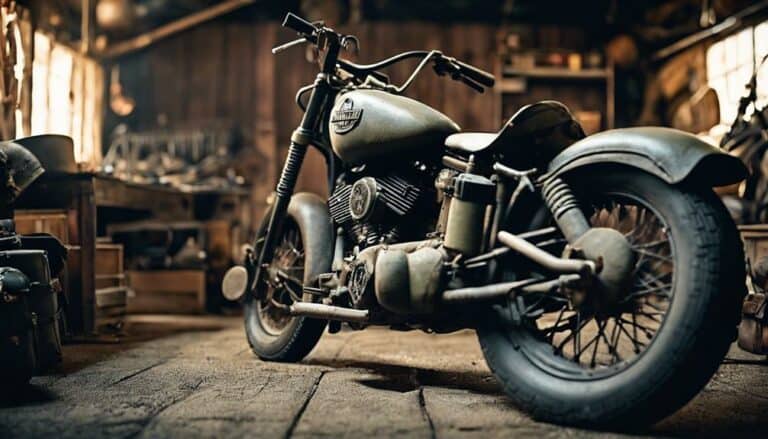You may have heard about the legendary Harley Davidson Army Bike, but do you truly understand its significance?
This iconic motorcycle, born out of wartime necessity, holds a unique place in military history and continues to captivate enthusiasts worldwide with its timeless design and enduring legacy.
But what exactly sets this two-wheeled powerhouse apart from the rest? Let's explore the secrets behind the Harley-Davidson WLA that make it a symbol of courage and resilience on the battlefield.
Key Takeaways
- Developed as the WLA model in response to a U.S. Army request during WWII.
- Military modifications included olive drab paint, blackout lights, and fender alterations.
- Renowned for agility and speed, ideal for scouting and reconnaissance missions.
- Symbol of American engineering prowess, sent to Allies under the Lend-Lease program.
Model Designation
The model designation of the Harley-Davidson Army Bike, specifically the WLA variant, is derived from the combination of letters representing its family, compression, and military affiliation. The 'W' indicates its lineage within the W series of Harley-Davidson motorcycles. The 'L' signifies the high compression engine, a feature that set it apart from its civilian counterparts. Lastly, the 'A' denotes its primary use by the Army. This naming convention not only distinguished the WLA as a military-specific model but also highlighted its enhanced performance capabilities compared to standard models.
Under the Lend-Lease program during WWII, the Harley-Davidson WLA motorcycles were supplied to allied nations such as the UK and South Africa. This strategic initiative facilitated the transfer of military equipment to support the war effort of these nations without immediate payment, strengthening the allied forces. The WLA's robust design, reliability, and adaptability in various combat conditions earned it the moniker 'Liberator,' symbolizing its role in bringing freedom to occupied territories.
History
Originating as a response to a specific U.S. Army request, the development of the Harley-Davidson WLA marked a significant milestone in military motorcycle history. The US Military sought a rugged and reliable machine, leading to the birth of the WLA in the late 1930s. Production commenced in 1940, ramping up significantly during World War II to meet the escalating demands of the conflict.
Based on the civilian model WL, the Harley-Davidson WLA underwent modifications to suit military requirements, such as blackout lighting and simplified electrical systems, ensuring optimal performance in various terrains. These enhancements facilitated its versatility in military operations, where it served crucial roles like reconnaissance, courier duties, and troop transportation.
Additionally, under the Lend-Lease program, numerous WLAs were sent to Allies, further solidifying its impact on the global stage during WWII. The Harley-Davidson WLA not only met but exceeded expectations, becoming an enduring symbol of American engineering prowess and military innovation.
Military Changes
In response to the U.S. Army's specific requirements, the Harley-Davidson WLA underwent significant military changes to enhance its functionality and adaptability for various operational needs. These modifications included:
- Application of olive drab paint to provide camouflage and corrosion resistance.
- Addition of blackout lights to reduce visibility during nighttime operations.
- Alteration of fenders to prevent mud clogging and ensure optimal performance in challenging terrains.
- Availability of accessories such as luggage racks, ammo boxes, and skid plates for military customization based on mission requirements.
- Installation of an oil bath air cleaner on WLA motorcycles to protect the engine from dust and debris commonly encountered in dusty environments.
These military changes not only improved the overall effectiveness and durability of the WLA motorcycles but also showcased Harley-Davidson's commitment to meeting the rigorous demands of military operations.
The attention to detail in these modifications highlights the brand's dedication to providing reliable and adaptable vehicles for military use.
Uses
With its versatile design and specialized modifications, the Harley-Davidson WLA served a variety of essential roles for the US Army during WWII. Primarily utilized for scouting and courier duties, the WLA played a crucial part in gathering intelligence and facilitating communication on the front lines. Its agility and speed made it ideal for reconnaissance missions, allowing soldiers to quickly gather information about enemy movements and positions.
While the WLA had limited capacity for transporting radio equipment, it was rarely equipped with sidecars for combat purposes by the US Army. However, the Soviet WLAs were often seen with sidecars in frontline battles, demonstrating their adaptability and versatility in different operational contexts. The WLA's modifications, such as olive drab paint, blackout lights, and altered fenders, were tailored to meet the specific needs of military use, ensuring its effectiveness in various wartime scenarios. The nickname 'Liberator' aptly reflects the critical role the WLA played in liberating occupied territories in Europe during the war, showcasing its significance in the US Army's operations.
Technology
Featuring a reliable side-valve engine design, the Harley-Davidson WLA showcases a blend of durability and performance in its technological composition.
Here are some key technical aspects of the Harley-Davidson WLA:
- The WLA is powered by a V-Twin engine, known for its power and torque delivery.
- Its side-valve engine design, in production for an impressive 36 years, emphasizes reliability and ease of maintenance.
- The medium-compression ratio of the WLA's engine contributes to its longevity and robustness in various conditions.
- The utilization of springer front suspension enhances the bike's ability to absorb shocks, providing a smoother ride over rough terrains.
- Despite the advanced suspension system at the front, the rear wheel lacks suspension, earning the WLA the nickname 'hard tail' among riders.
These technological features combine to make the Harley-Davidson WLA a formidable and enduring machine, capable of handling the demands of military service with resilience and performance.
Conclusion
You have learned about the iconic Harley-Davidson WLA, a vital military motorcycle during World War II.
Did you know that over 90,000 units of the WLA were produced during the war, with many still in operation today?
This impressive number showcases the widespread use and reliability of this legendary army bike, solidifying its place in history as a symbol of Allied cooperation and bravery on the battlefield.

